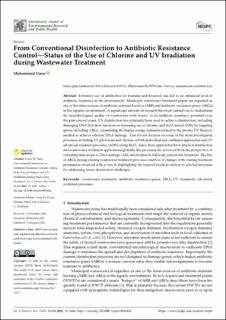| dc.contributor.author | Umar, Muhammad | |
| dc.date.accessioned | 2022-03-24T12:31:42Z | |
| dc.date.available | 2022-03-24T12:31:42Z | |
| dc.date.created | 2022-02-01T10:10:23Z | |
| dc.date.issued | 2022 | |
| dc.identifier.citation | International Journal of Environmental Research and Public Health (IJERPH). 2022, 19 (3), 1636. | en_US |
| dc.identifier.issn | 1661-7827 | |
| dc.identifier.uri | https://hdl.handle.net/11250/2987369 | |
| dc.description.abstract | Extensive use of antibiotics for humans and livestock has led to an enhanced level of antibiotic resistance in the environment. Municipal wastewater treatment plants are regarded as one of the main sources of antibiotic-resistant bacteria (ARB) and antibiotic resistance genes (ARGs) in the aquatic environment. A significant amount of research has been carried out to understand the microbiological quality of wastewater with respect to its antibiotic resistance potential over the past several years. UV disinfection has primarily been used to achieve disinfection, including damaging DNA, but there has been an increasing use of chlorine and H2O2-based AOPs for targeting genes, including ARGs, considering the higher energy demands related to the greater UV fluences needed to achieve efficient DNA damage. This review focuses on some of the most investigated processes, including UV photolysis and chlorine in both individual and combined approaches and UV advanced oxidation processes (AOPs) using H2O2. Since these approaches have practical disinfection and wastewater treatment applications globally, the processes are reviewed from the perspective of extending their scope to DNA damage/ARG inactivation in full-scale wastewater treatment. The fate of ARGs during existing wastewater treatment processes and how it changes with existing treatment processes is reviewed with a view to highlighting the research needs in relation to selected processes for addressing future disinfection challenges. | en_US |
| dc.language.iso | eng | en_US |
| dc.publisher | MDPI | en_US |
| dc.relation.uri | https://www.mdpi.com/1660-4601/19/3/1636 | |
| dc.rights | Navngivelse 4.0 Internasjonal | * |
| dc.rights.uri | http://creativecommons.org/licenses/by/4.0/deed.no | * |
| dc.title | From Conventional Disinfection to Antibiotic Resistance Control—Status of the Use of Chlorine and UV Irradiation during Wastewater Treatment | en_US |
| dc.type | Peer reviewed | en_US |
| dc.type | Journal article | en_US |
| dc.description.version | publishedVersion | en_US |
| dc.rights.holder | © 2022 by the author | en_US |
| dc.source.pagenumber | 20 | en_US |
| dc.source.volume | 19 | en_US |
| dc.source.journal | International Journal of Environmental Research and Public Health (IJERPH) | en_US |
| dc.source.issue | 3 | en_US |
| dc.identifier.doi | 10.3390/ijerph19031636 | |
| dc.identifier.cristin | 1996080 | |
| dc.source.articlenumber | 1636 | en_US |
| cristin.ispublished | true | |
| cristin.fulltext | original | |
| cristin.qualitycode | 1 | |

